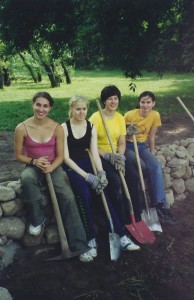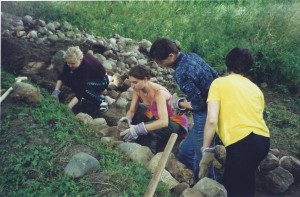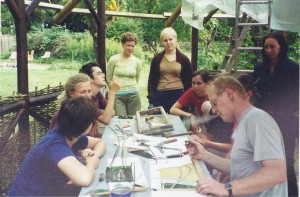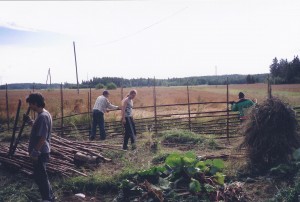
Sure, we’d all love to quit our jobs, run off to some unpronounceable locale and join the Peace Corps. But what if you can’t quit your job or commit to a 27-month stint away from home? Long-term placements aren’t for everyone, but don’t worry: they’re not the only option.
At the ripe old age of 17, I decided I wanted to backpack across Europe — by myself. After my parents recovered from their initial shock, my mother turned to Google and stumbled upon a little-known organization called Volunteers for Peace. Founded in 1982 as not-for-profit corporation dedicated to “promoting peaceful relations among nations,” VFP was accepted into the Coordinating Committee for International Voluntary Service at UNESCO in Paris and its Board of Directors remains comprised of former volunteers and individuals committed to promoting peace through voluntary service projects.
Having never been a fan of follow-the-flag tourism, I knew I didn’t want to spend my summer wearing a name-tag and hanging out with other Americans. The entire point of going abroad was to meet foreigners! I wanted to get off the beaten path and, being an idealistic teenager at the time, I also wanted to give back. By June, I was on my way to Paris with nothing more than my backpack, my passport and my Eurail pass. Soon thereafter, I caught a train to Ehmkendorf, a tiny village outside of Rostock in northern Germany, where a smiling blond with dreadlocks greeted me.
“You are here for the workcamp?” she asked.
I nodded, relieved to learn that I’d come to right place despite my non-existent German.
“Willkommen,” she replied. To my great delight, I was the only American at the workcamp. The other volunteers, who ranged in age from 16 to 20-something, hailed from every corner of the globe. I bunked with a girl from Finland, completed my KP duties with a boy from Lithuania and spent the weekend shopping with my new friends from Korea.

Our task during the three-week placement was to assist with the renovation of an eighteenth-century farmhouse. We worked from 9 a.m. until 2 or 3 p.m. on weekdays, and every evening our hosts would take us on some sort of excursion. To say the experience changed my life would be an understatement. You try working—and living—with a dozen internationals for three weeks. I returned to the U.S. with a totally new perspective and, admittedly, a major expat chip on my shoulder.
Of course, volunteering abroad is a bit easier when you’re young and in school and can simply up-and-go whenever you feel like it, but VFP, which celebrates its 30th anniversary this year, is one of the best-kept secrets in international travel. I spent three weeks in Germany for less than $400 dollars (which amounts to less than $20 a day for the budget-conscious amongst us). This is because VFP charges a flat registration fee of $300 for all volunteers ages 18 and up, regardless of the program’s length or location—and believe me, there are plenty of options in both departments. You’re responsible for your own airfare but meals, accommodations, supplies and even the occasional weekend excursion are covered. VFP publishes an online directory each year in which would-be volunteers can search for available placements by country, duration, language requirements and type of work.
Granted, not everyone wants to spend three weeks in the middle of nowhere sleeping in a rundown manner house without the benefit of running water but, as voluntourism is on the rise and these days, there’s something for everyone. Tambor Tropical, a boutique resort in Costa Rica, invites guests to volunteer for three hours a day at the nearby Tambor Bay School. Working with the school’s teaching staff, guests have delivered lessons and workshops in everything from dental hygiene to journalism. Transportation to and from the school is provided and rates range from $160-$220 per night.

On the other end of the spectrum, Hands Up Holidays specializes in luxury, tailor-made tours that blend sightseeing with a “taste” of volunteering. Guest can choose from tours in nearly 40 different countries ranging from Bolivia to Bhutan, but a nine-day trip costs between $3,500-$5,000, not including airfare.
Biosphere Expeditions, which charges between $1,870 and $2,500 for a two-week project, has recently started offering a variety of “Sampler Days” throughout the U.S. The day-long “tasters” cost $95 ($50 of which is credited towards the cost of a regular expedition if the volunteer decides to participate in a full-length program) and offer interested parties the chance to learn various wildlife conservation skills such as interpreting animal tracks and using a compass.
Altruism aside, it’s important to remember that voluntourism is an industry—and a booming one at that. Would-be do-gooders need to be educated consumers. Voluntourism consultant Alexia Nestora advises volunteers to ask where their participation fees are going: “People think their $1,500 is going to the project and then they do the math […]. It only costs $2/day to eat, the host family isn’t paid because they get free English lessons from volunteers and all of a sudden the volunteers feel ripped off. Knowing where your money is going is essential to having a great in-country experience.”
Recently, several orphanages have also come under scrutiny for the exploitative nature of their volunteer programs. Volunteers interested in working with children should ensure that the orphanage is linked to a social worker; furthermore, programs in which well-intentioned but under qualified volunteers are allowed to engage in “counseling” work with disadvantaged children should raise a few questions.

That said, I’ve completed three workcamps since my initiation nearly 10 years ago: one in Germany, one in southern Italy and one in Finland. I now know how to swear in all the major Slavic languages, how to make crepes the “real” way and how to sharpen an axe on a traditional whetstone (and yes, I’m sure the last of these really will come in handy one of these days).
So if you’re sitting there thinking, “Gee, I’d really love to travel abroad but I just can’t afford it/don’t speak any foreign languages/wouldn’t know where to begin,” stop. Stop now. I did it at 17, and I’m hardly the world’s most intrepid traveler. If you’d like to imbibe your next round-the-world jaunt with something new, or perhaps ease your way into international travel, volunteering abroad is the way to go and VFP might be just the ticket—and a heavily discounted one at that.

